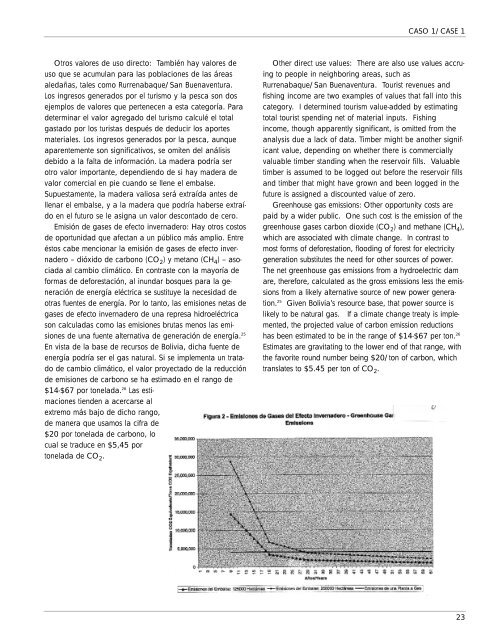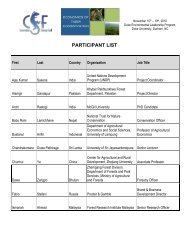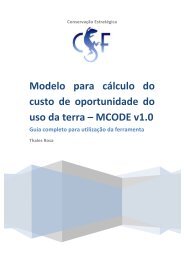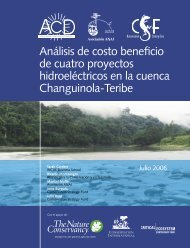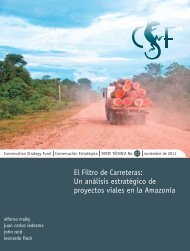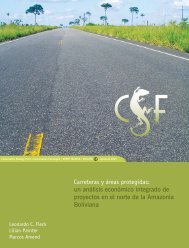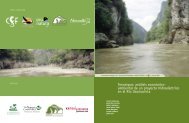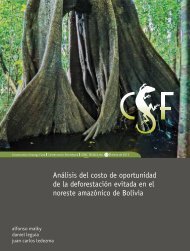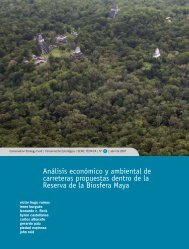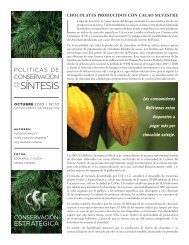Download (1.95 MB) - Conservation Strategy Fund
Download (1.95 MB) - Conservation Strategy Fund
Download (1.95 MB) - Conservation Strategy Fund
- No tags were found...
Create successful ePaper yourself
Turn your PDF publications into a flip-book with our unique Google optimized e-Paper software.
CASO 1/CASE 1Otros valores de uso directo: También hay valores deuso que se acumulan para las poblaciones de las áreasaledañas, tales como Rurrenabaque/San Buenaventura.Los ingresos generados por el turismo y la pesca son dosejemplos de valores que pertenecen a esta categoría. Paradeterminar el valor agregado del turismo calculé el totalgastado por los turistas después de deducir los aportesmateriales. Los ingresos generados por la pesca, aunqueaparentemente son significativos, se omiten del análisisdebido a la falta de información. La madera podría serotro valor importante, dependiendo de si hay madera devalor comercial en pie cuando se llene el embalse.Supuestamente, la madera valiosa será extraída antes dellenar el embalse, y a la madera que podría haberse extraídoen el futuro se le asigna un valor descontado de cero.Emisión de gases de efecto invernadero: Hay otros costosde oportunidad que afectan a un público más amplio. Entreéstos cabe mencionar la emisión de gases de efecto invernadero– dióxido de carbono (CO 2 ) y metano (CH 4 ) – asociadaal cambio climático. En contraste con la mayoría deformas de deforestación, al inundar bosques para la generaciónde energía eléctrica se sustituye la necesidad deotras fuentes de energía. Por lo tanto, las emisiones netas degases de efecto invernadero de una represa hidroeléctricason calculadas como las emisiones brutas menos las emisionesde una fuente alternativa de generación de energía. 25En vista de la base de recursos de Bolivia, dicha fuente deenergía podría ser el gas natural. Si se implementa un tratadode cambio climático, el valor proyectado de la reducciónde emisiones de carbono se ha estimado en el rango de$14-$67 por tonelada. 26 Las estimacionestienden a acercarse alextremo más bajo de dicho rango,de manera que usamos la cifra de$20 por tonelada de carbono, locual se traduce en $5,45 portonelada de CO 2 .Other direct use values: There are also use values accruingto people in neighboring areas, such asRurrenabaque/San Buenaventura. Tourist revenues andfishing income are two examples of values that fall into thiscategory. I determined tourism value-added by estimatingtotal tourist spending net of material inputs. Fishingincome, though apparently significant, is omitted from theanalysis due a lack of data. Timber might be another significantvalue, depending on whether there is commerciallyvaluable timber standing when the reservoir fills. Valuabletimber is assumed to be logged out before the reservoir fillsand timber that might have grown and been logged in thefuture is assigned a discounted value of zero.Greenhouse gas emissions: Other opportunity costs arepaid by a wider public. One such cost is the emission of thegreenhouse gases carbon dioxide (CO 2 ) and methane (CH 4 ),which are associated with climate change. In contrast tomost forms of deforestation, flooding of forest for electricitygeneration substitutes the need for other sources of power.The net greenhouse gas emissions from a hydroelectric damare, therefore, calculated as the gross emissions less the emissionsfrom a likely alternative source of new power generation.25 Given Bolivia’s resource base, that power source islikely to be natural gas. If a climate change treaty is implemented,the projected value of carbon emission reductionshas been estimated to be in the range of $14-$67 per ton. 26Estimates are gravitating to the lower end of that range, withthe favorite round number being $20/ton of carbon, whichtranslates to $5.45 per ton of CO 2 .23


